#essentially fan-works are not necessarily art they come from the absence of art
Explore tagged Tumblr posts
Text
am considering fanart* through the lens of the theory ive been reading (a lot of marxist and poststructuralist stuff rn but also all the modern things from other classes) and i firmly believe that it springs from lacking elements in the source material and i think that the thing that is most often lacking is human touch
*works created in response to but not in conversation with media (also a critical distinction)
#its also pure instant-gratification-pleasure-wish-fullfilment-entertainment and like its giving samizdat#it comes from alienation between people and the lack of access to the means of creation#and its also why the most dogshit/soulless/corporate franchises (franchises) have such active fandoms#because so many people want to see the human touch in the work but theres none there#and so they have to make it themselves#essentially fan-works are not necessarily art they come from the absence of art#if one of the characteristics of art is human touch (which i would argue is one of the only inarguable characteristics of art)#txt
7 notes
·
View notes
Text
WandaVision: ‘Subverting’ Good Television - Quill’s Scribbles
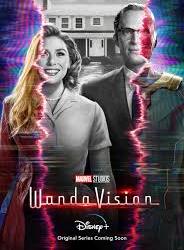
(Spoilers for the first five episodes)
Hey everyone! Well... it’s been a while, hasn’t it? The last time I wrote a proper review or Scribble, people still thought the COVID crisis would be over within a month. The poor saps. But I thought that as a special way to mark this year’s Valentines Day, we could take a closer look at the Marvel Cinematic Universe’s shittiest power couple in their new Disney+ show WandaVision.
The first of many MCU spin-off shows that nobody asked for, broadcast exclusively on Disney’s totally unnecessary streaming platform, WandaVision is about everybody’s favourite whitewashed Nazi experiment and her red sexbot boyfriend as they try to fit into a suburban sitcom neighbourhood without arousing suspicion.
Yes, you read that correctly. The MCU has a sitcom now. My life is now complete.
Sarcasm aside, I was legitimately curious about WandaVision because of its unusual setting. And considering one of my most common criticisms of the MCU is its total lack of creativity, anything that’s even a little bit subversive is bound to attract my attention. Of course ‘subversive’ doesn’t necessarily mean ‘good.’ I could hand you a canvas smeared with my own shit and call it subversive. That doesn’t necessarily make it good art. And that’s exactly what WandaVision is. A canvas smeared with shit.
So lets split this critical analysis/review/angry bitter rant into two distinct chapters. The first focusing on the plot and setting, and the second focusing on the characters. Okay? Okay.

Chapter 1: Bewitched
Critics seem to be utterly enamoured with the whole sitcom gimmick, and it is a gimmick. As far as I can tell from the episodes I’ve seen, the sitcom setting serves no real purpose whatsoever other than to make the show ‘quirky.’ Which I wouldn’t mind, believe it or not, if the show was actually funny. There’s just one problem. It’s not.
Now in some ways describing why a sitcom doesn’t work is often futile because comedy is largely subjective. What I find funny, you won’t necessarily find funny and vice versa. With WandaVision, however, I won’t have that problem. I can demonstrate to you precisely why WandaVision, objectively, isn’t funny. And it all comes down to one simple thing. The stakes. Or rather the complete and total absence of stakes.
The show makes it very clear from the beginning that none of what we’re seeing is real. The cheesy theme song, the era appropriate special effects (mostly. It’s actually very inconsistent), the joke commercials, and, in the case of the first two episodes, which are in black and white, the appearance of red lights and objects in Scarlet Witch’s general vicinity. (Gee, what a mystery this is).
Basically Wanda has brought Vision back from the dead and created this sitcom world for them to inhabit. I’ll explain the stupidity of this in Chapter 2. The point is none of this is real, and that has a negative effect on the comedy because the very nature of comedy is suffering. Take the plot of the first episode. Wanda and Vision have to prepare a dinner to impress Vision’s boss. If they fail, Vision could lose his job and the couple could be exposed as superheroes. If this were a normal sitcom, it would work. The stakes are clear and it would be satisfying to see the two struggle and overcome the odds. But here, we know it’s not real. If it’s not real, it means there’s no stakes. If there’s no stakes, it means there’s no suffering. If there’s no suffering, there’s no comedy.
It would be one thing if the unfunny sitcom stuff lasted for like the first ten minutes or so before making way for the actual plot, but it doesn’t. Oh no. It doesn’t even last for the first episode. Out of the five episodes I’ve watched, four of them are almost entirely about these unfunny, objectively flawed sitcom homages, each set in a different time period. The fifties, the sixties, and so on. And what’s worse is that nothing that happens in them is plot-relevant. That gets relegated to the last five minutes of an episode. So you’re forced to sit through twenty five minutes of boring slapstick and puns in order to catch even a whiff of actual story. Which begs the question... who is this for exactly? It can’t be entertaining to Marvel fans, who have to slog through all this pointless shit so they can figure out what the fuck is going on. Comedy fans may get a kick out of the sitcom pastiche at first, but after four episodes, surely the joke would wear thin. So why is it in here? Clearly someone in the writer’s room absolutely fell in love with the idea of doing a Marvel sitcom, but nobody put in any time or effort to figure out how it would work in context.

I cannot stress enough how bad the plotting of this series is. As I said, the vast majority of a thirty minute episode is about shitty sitcom plots that aren’t funny and don’t have any impact on the story, only to then tease you with a crumb of actual plot in order to keep you coming back for the next instalment. Admittedly it’s an effective strategy. I was more than ready to quit after Episode 2 until that beekeeper showed up out of the sewer (don’t ask. It’s not important). WandaVision essentially follows the Steven Moffat school of bad writing. String your audience along with the promise that things might get more interesting later on and that all the bullshit that came before will retroactively make sense by the end. Except, as demonstrated with BBC’s Sherlock, that doesn’t work. And even if it did, it wouldn’t justify wasting the audience’s fucking time. And that’s what the majority of WandaVision is. A waste of time.
The only episode that doesn’t follow the sitcom format is the fourth episode. Instead it basically exists to explain all the shit that happened before. The shit that the audience, frankly, are smart enough to figure out for themselves. Wanda created the sitcom world as a way of coping with the loss of Vision, blah, blah, blah. Yeah, we got it. Thanks. It doesn’t advance the plot or anything. It’s just a massive info-dump. But by far the lowest point was when Darcy (by far the most annoying character in the first Thor film and is just as obnoxious here) was sat in front of the TV, watching the sitcom and asking the same questions we were. Not even attempting to look for answers. Just reiterating what the audience is thinking. Like this is an episode of fucking Gogglebox.
In the end it becomes apparent why the series is structured the way that it is. It’s to hoodwink people into subscribing to Disney’s stupid streaming service. If you think about it, there was no reason for WandaVision to be a TV series other than to lure gullible fans in with a piece-meal story buried in a mountain of crap. This isn’t a TV show. It’s what is cynically known in the world of big business executives as ‘content.’ They’re not interested in entertaining the audience. Instead they crave ‘engagement’, which isn’t the same thing. Watching WandaVision is like staring into the void, waiting for something to happen, while Disney charge you for the privilege.
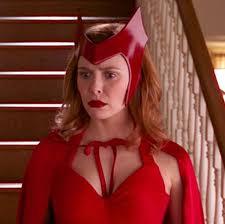
Chapter 2: I Love Lucy
So the plot sucks balls. What about the characters? Surely if Wanda and Vision are likeable at least, it’ll give us something to cling onto.
Well as I was watching the first episode, it suddenly hit me that I couldn’t remember anything that happened to them in previous films. I knew Vision died, but other than that, I couldn’t tell you significant plot details or their personalities or anything. Not a great start.
See, up until now, Vision and Scarlet Witch have been little more than background characters. So already there’s an uphill struggle to get us invested in their relationship, especially considering we haven’t actually seen that relationship develop. In Avengers: Age Of Ultron, Scarlet Witch is killing people because she’s pissed off about Tony Stark killing people (you work that one out) until all of a sudden she stops and joins the good guys because the script said so. Vision meanwhile is introduced as a convenient deus ex machina to beat Ultron and gets no real personality other than he’s a robot. Captain America: Civil War comes the closest to giving Wanda a story and personality of her own as it’s her actions that cause the Sokovia Accords to come into effect, but she never gets any real growth or payoff as the film is heavily focused on Cap and Iron Man’s penis measuring contest. And as for Vision, all he does in the film is accidentally cripple War Machine. No real character or arc there as such. And then we have Avengers: Infinity War, where Wanda and Vision are now sporadically in love and on the run until that pesky Josh Brolin, looking like a CGI cross between Joss Whedon and a grumpy grape, comes along and rips out Vision’s Infinity Stone to power up his golden glove of doom, and the film treats this like a tragic moment, except... it isn’t. Because we haven’t really had the time to properly get to know these characters and see their romance blossom. So instead it just comes off as hollow and forced.
WandaVision has the exact same problem. Apparently Wanda was so distraught about Vision’s death that she broke into a SWORD base, stole his corpse, brought it back from the dead... somehow, and then enslaved an entire town of people to create an idyllic lifestyle for her and her hubby while broadcasting it as a sitcom to the outside world... for some reason. Putting aside the dubious morality of it all, it’s impossible to really sympathise with Wanda or her supposed grief because we’ve barely spent any time with her. Had the Marvel movies taken the time to properly explore the characters and show us their relationship grow and develop, this might have had more emotional resonance. But no, it just happens. In one film they barely speak to each other and in the next they’re a couple. No effort to explore how they feel about each other or any of the problems that may arise trying to date a robot. It just happens and we’re just supposed to care. Well I’m sorry, but I don’t care. You’re going to have to try a little bit harder than that I’m afraid. What’s worse is that, thanks to the whole fake sitcom thing, it’s impossible to really become invested in Wanda and her plight because the show has to constantly keep us at arms length at all times in order to keep up the pretence that this bullshit is somehow mysterious.
Looking through the WandaVision tag, it amuses me how many people say that she’s acting out of character. And yeah, her actions are a bit of a head scratcher. Why would an Eastern European’s ideal life be an American sitcom? Why a sitcom? Why kidnap an entire town? Why keep changing the decade? None of it makes sense, but you’re wrong for thinking that Wanda is behaving out of character for the simple reason that Wanda has never actually had a character. In fact, ironically, Wanda mind controlling an entire town and forcing them to do her bidding is probably the one consistent thing about her as she did this in Age Of Ultron. In interviews, Elizabeth Olsen and Paul Bettany described how they used actors like Elizabeth Montgomery and Dick Van Dyke as influences, which is really funny because they’re straight up admitting they don’t have characters and even now they’re still not playing the characters, instead emulating the work of far better actors.
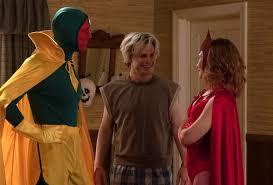
As I was watching the show, it became abundantly clear that not only do Marvel not have the faintest idea what they wanted to do with these characters, but they also straight up don’t give a shit about these characters. Wanda in particular has had a rough time under the tyrannical regime of the House of Mouse. First they cast Elizabeth Olsen, a white woman, to play a Romani character, then systematically erasing her Jewish roots, even going so far as to put a cross in her bedroom in Civil War, and now the character is being butchered even more by forcing her into an American sitcom housewife role that she apparently willingly chose for herself, which is laughable. I mean say what you like about Magneto in the X-Men films, at least they actually depicted his Jewish culture. At least they recognised his Jewish background was important (though not important enough to cast a Jewish actor apparently). Wanda’s steady cultural erasure over the years is incredibly insidious and judging by Olsen’s comments in interviews, where she called Wanda’s comic book outfit a quote ‘gypsy thing’ unquote, it seems nobody has an ounce of fucking respect for the character or the culture she’s supposed to be representing. (and to all those kissing her arse saying it was a slip of the tongue, she has been repeatedly called out for using the slur in the past, so at this point I’d describe her behaviour as wilful ignorance)
If you want further proof of how much Marvel doesn’t seem to care about Wanda, look no further than her brother Pietro, aka Quicksilver. At the end of Episode 5, Wanda brings Pietro back from the dead, except it’s not Pietro. It’s Peter Maximoff, the Quicksilver from the X-Men films played by Peter Evans, who coincidentally is not Jewish or Romani either. So Quicksilver has the dubious honour of not only being whitewashed three times, but also twice within the same franchise. But should we really be surprised at this point? It’s Marvel after all. The same company that whitewashed the Ancient One in Doctor Yellowface and claimed it wasn’t racist because Tilda Swinton is ‘Celtic’. But now I’m going off topic. My point is that this isn’t a simple case of recasting an actor like Mark Ruffalo replacing Edward Norton as the Hulk. WandaVision actually acknowledges the recast in-universe, which makes no sense. Why would Wanda bring back her brother, only to make him look like a different person? We the audience may be familiar with this version of Quicksilver, but she isn’t. That would be like me bringing my Grandad back to life and making him look like Ian McKellen. He’d be perfectly charming, I’m sure, but he wouldn’t be my Grandad.
If Marvel really cared about the characters or narrative consistency, they would have brought Aaron Taylor Johnson back. Instead, now they have absorbed 20th Century Fox into the hellish Disney abyss, they use X-Men’s Quicksilver as a means to keep viewers from switching off and so that people will write stupid articles and think pieces about whether the rest of the X-Men will show up in the MCU. It’s like dangling your keys in front of a toddler’s face to distract them from the rotting corpse of a raccoon lying face down in the corner of the room.
And it’s here where I decided to stop watching the show because fuck Disney.
Epilogue: One Foot In The Grave
You know, I am sick and tired of the so called ‘professional’ critics bending over backwards to praise these god awful films and shows when it’s so clear to anyone with a functioning brain cell how bad they truly are. WandaVision is without a doubt one of the most cynically produced and poorly structured TV shows I’ve ever seen. Its riffs on classic sitcoms are pointless and self-indulgent, the writing is terrible, the characters are unlikable and unsympathetic, and it’s entirely emblematic of what the entire MCU has become of late. And it’s only going to get worse as Disney drowns us with more ‘content’ to keep the plebs ‘engaged’. In short; pathetic.
189 notes
·
View notes
Note
I read on your latest art post that you see parallels between Orochimaru and Sakura. That's interesting; usually he's linked to Sasuke. Please elaborate on your thoughts. Also, fantastic art! You are a gift to the world! Thanks for sharing!
Aaah anon, you are so sweet!! Thank you so much, I’m glad you liked the art! 💜 And sure! I’m sticking it under a cut because, well, I can never be brief :D
So, I’ve always felt like, even though Sakura has obvious parallels with Tsunade (her temper, super strength, etc.), a lot of those are only surface level. And a bunch of them, in my opinion, were actually instilled by Tsunade herself (the super strength, for instance; if Sakura had trained under someone else, she wouldn’t necessarily have developed that ability. It’s not necessarily an innate quality of hers, though to have taken to it so wholeheartedly, the potential was obviously there). If you look a bit deeper into her circumstances and how she responds to adversity, she’s actually a lot more similar to Orochimaru:
Both were the ones left behind by their teammates: The timeline is a little unclear as usual XD as to the order of things during the Second War, but generally speaking Jiraiya left his team and Konoha for 3 years to teach the Ame orphans, and it’s strongly implied that he only ever stayed at the village for brief stints after that; primarily, he’s shown to be busy travelling, establishing his spy network and searching for the child of prophecy. Likewise, ever since meeting Jiraiya during the Chunin Exams, Naruto was mostly out of the village training and travelling with him, even before he officially left on his long three year absence. Tsunade left Konoha permanently after Dan’s death; and I’m fairly certain the only reasons she wasn’t branded a missing nin were Hiruzen being the Hokage at the time and her lineage, because she essentially walked out and vanished. It’s either stated or strongly implied, I believe by the village elders, that they repeatedly sent out people to track her down and failed? I’d have to go back and double check, but I’m pretty sure something like this is mentioned when Homura and Koharu talk to Jiraiya about becoming Hokage, right after Orochimaru’s attempt to destroy the village. Likewise, Sasuke left Konoha permanently for training with Orochimaru, and also had people repeatedly trying to track him down. Meanwhile, Orochimaru was left behind still working for the village -- training Anko, working as ANBU/Root, working with Danzo who, despite what anyone thinks of him, still counts as village leadership. Everything Orochi did while in Konoha was actually endorsed by the government (regardless of whether it also lined up with his personal interests or not), whether directly by Danzo’s orders or indirectly through Hiruzen refusal to acknowledge or examine anything Danzo was doing. Sakura was left behind, also still working for the village; in her case, this took the form of pursuing her own training, developing new skills, joining up with other teams to run missions, etc.
.
Both of them reacted to loss by fixating on getting stronger and throwing themselves into their work: Orochimaru, after losing Jiraiya and Tsunade (and Dan and Nawaki, and seeing how their deaths broke Tsunade -- I think that was really the last straw for him), started pursuing his goal of learning all jutsu and attaining immortality with a single-mindedness that had not been there before. His fixation on these, at least to me, comes across as the simple desire to build himself up in such a way that he’ll never be affected by loss again. Similarly, after Naruto and Sasuke both left, Sakura approached Tsunade and essentially demanded of her to train her up. She also threw herself into learning and excelling in medical ninjutsu, building up her taijutsu skills and attaining incredible physical strength -- again, in an effort to ensure that she’d be strong enough to face whatever life threw at her next. Specifically in this case, she bears no similarity to Tsunade, whose reaction to loss was to cut ties and run, hiding indefinitely while giving in to her bad habits. (No judgement on Tsunade here, I totally understand and support her reacting to the events in her life like this, I’m just pointing out that she’s basically the opposite to Sakura in this regard). Both Orochi and Sakura reacted to loss by taking the strength equals survival mentality to heart, and being more driven than ever in terms of improving themselves.
.
Both have an interest in the human body: For Orochimaru, this interest manifests more in terms of genetics, biology, pushing the limits of what is possible, experimentation, etc. It is the darker side of science that, occasionally, intersects with what Tsunade practices. For Sakura, it’s the medical field, specifically with a mind towards healing. However, given what we saw of her behaviors, thought processes, and abilities during the arc with Sasori and Chiyo, I personally can see Sakura having the affinity to specialize in things like poisons. Had it not been Tsunade that was available to train under when Sakura was at her lowest and darkest point and it had been someone like, say, Kabuto? I definitely think Sakura could have easily gone down a darker path in medial ninjutsu; one that still incorporated healing, of course (Kabuto is still extremely adept at being a healer), but possessing a large repertoire of how to cause damage to the body as well. This is my own interpretation, obviously, but I do think that the benign nature of Sakura’s medical training has more to do with who her teacher was than with Sakura herself; I have no doubt that she has the capacity of being as devastating as Kabuto within the medical field, and that could have been quite easily nurtured back when she was freshly abandoned by her teammates and left to pull herself back together, determined to catch up to them.
.
Neither comes from a prestigious shinobi lineage: We have no clue who Orochimaru’s parents were. A popular fan theory is that they were ninja who were killed in the line of duty, but unless I’m forgetting something, we’re never actually given canon confirmation of that. All we know is that they died while he was very young, which is what started him on his path of questioning life, death, mortality, etc. Sakura’s parents, as we know, are civilians and, from all appearances, don’t really seem to have any clue as to what life as a ninja is about. Unlike Sasuke (an Uchiha and Indra’s incarnation), Tsunade (a Senju and granddaughter of the First Hokage), Naruto (the Kyuubi jinchuriki, son of the Fourth Hokage and the previous Kyuubi jinchuriki, an Uzumaki, and Ashura’s incarnation), Orochi and Sakura didn’t really have anything going for them in terms of bloodline. (We know nothing of Jiraiya’s parents other than the implication that they didn’t die while he was young, so he falls in this category too). That’s not to say that Sasuke, Tsunade, and Naruto didn’t also work their asses off to get to where they did; they absolutely did. But Orochimaru and Sakura (and Jiraiya) had less to work with, even if Orochi was naturally gifted with things like ninjutsu and hailed as a genius. Also, that kind of division -- between clan kids and non-clan kids -- isn’t really explored that much in the series, but it’s something that would definitely affect a shinobi’s mentality and outlook on things growing up. (Obviously, this last part doesn’t apply to Naruto -- he grew up a clan-less orphan, for all intents and purposes, but you get the idea).
That’s what I can think of off the top of my head for now! If anything else occurs to me, I’ll reblog this and add to it ^^ Hope that was a satisfactory answer!
#first thing i see this morning is sweet anon in my inbox in response to my art#and asking me to talk about my faves?#i'm gonna be like :D :D :D all day now#thanks so much for dropping by!#Anonymous#orochimaru#sakura
18 notes
·
View notes
Photo

For the week of 27 August 2018
Quick Bits:
A Walk Through Hell #4 focuses largely on flashbacks to the case the agents were working before whatever’s currently happening happened and...I’m not really sure of anything that’s going on. I think that’s kind of the point, unsure as to how everything is supposed to connect and what any of it all adds up to. Great art from Goran Sudžuka and Ive Svorcina, though.
| Published by AfterShock



Beyonders #1 is off to a great start. Between this and The Lost City Explorers, it seems like AfterShock right now has pseudoarchaeology stitched up and it’s wonderful. Paul Jenkins, Wesley St. Claire, and Marshall Dillon kick this one off with a wee bit more crunch, though there’s a very interesting upheaval this issue that will make you wonder what’s going on.
| Published by AfterShock



Blackwood #4 brings this series to an end and it is dark. Very dark. Evan Dorkin, Veronica & Andy Fish have crafted a wonderful horror story here, with some interesting twists, and one hell of an ending.
| Published by Dark Horse



Bone Parish #2 takes a deep dive in to some of the foundational moments of the Winters clan, even as they begin to deal with the fallout of one of their dealers dying from an overdose. This is great stuff. The art from Jonas Scharf and Alex Guimarães is incredible. Great detail and atmosphere, perfectly bringing to life the premise and characters from Cullen Bunn.
| Published by BOOM! Studios

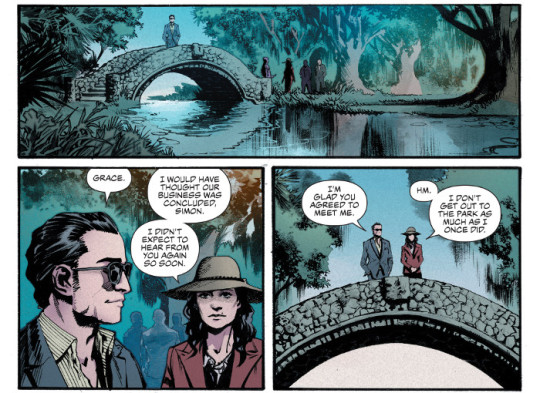

Brothers Dracul #5 circles back around to the beginning of the story, as we reach the end of this interesting retelling and interpretation of the intersection of both the historical and legendary story of Vlad the Impaler, from Cullen Bunn, Mirko Colak, Maria Santaolalla, and Simon Bowland. There’s an interesting twist here that certainly paints Vlad’s action in a different light, and I hope we see it followed up upon in a second series.
| Published by AfterShock

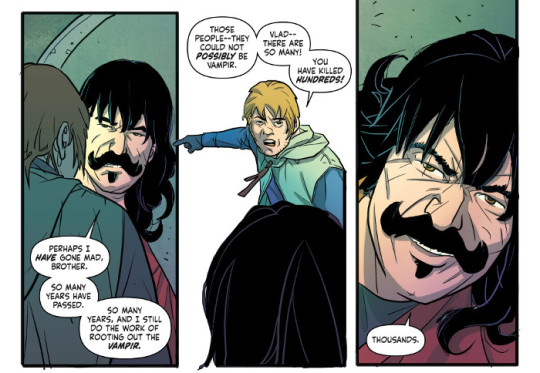

Cyber Force #5 is a nice change of pace as Bryan Hill, Matt Hawkins, Atilio Rojo, and Troy Peteri introduce us to another old familiar face. This incarnation of the team definitely is taking its time to be brought together, but when the storytelling is as entertaining and the artwork is as gorgeous as this, it doesn’t really matter. To note, though, this is not the kind of decompression that feels empty or padded, it’s just fleshing out characters and their lives more than what we’ve seen before.
| Published by Image / Top Cow



Daredevil Annual #1 presents a standalone story of Misty Knight’s days as a detective and her first meeting with Daredevil. It’s good. It feels a bit more like a pilot for a Misty Knight series than necessarily a Daredevil tale, but, as I said, it’s good. The art from Marcio Takara and Marcelo Maiolo is nice. I really like Takara’s style which gives me hints of Phil Hester, Jim Mahfood, and Tomm Coker.
| Published by Marvel

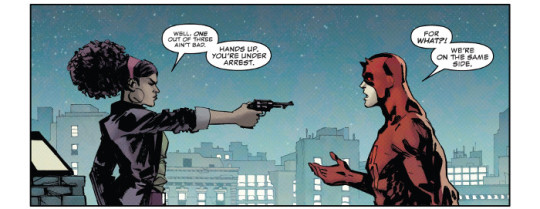

Dungeons & Dragons: Evil at Baldur’s Gate #5 is another fun one, with a focus this issue on Boo. I’ve really enjoyed this series, with Jim Zub giving the party a bit of a breather between larger adventures and giving a great look at them as individual characters. Great art, too, including this issue from Francesco Mortarino and Jordi Escuin.
| Published by IDW

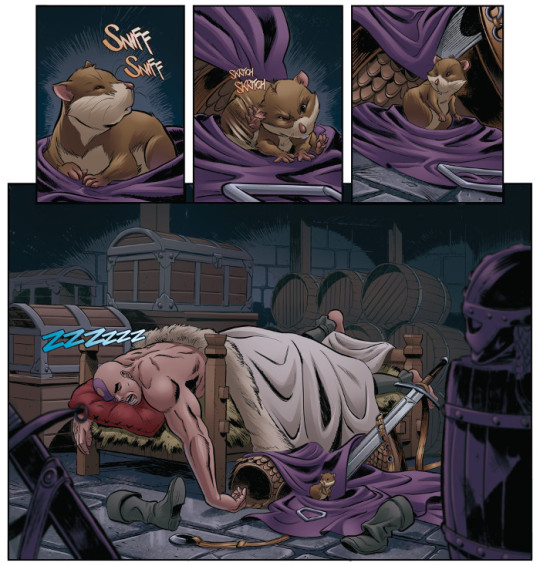

Edge of Spider-Geddon #2 gives us a view into another alternate Spiderverse, circling back around to SP//dr, and giving us a new twist on the power and responsibility rubric and VEN#m. It’s nice to see Lonnie Nadler and Zac Thompson play with more technological horror, with some incredible artwork from Alberto Alburquerque and Tríona Farrell.
| Published by Marvel



Euthanauts #2 is a thing of beauty. Nick Robles and Eva De La Cruz are seriously delivering some of the best art in comics right now with this series. The page layouts, character designs, use of colour, and incorporation of lettering choices from Aditya Bidikar, just elevate the storytelling immensely. Not even to mention how Tini Howard is making the weird science seamless in the dialogue. This is great.
| Published by IDW / Black Crown

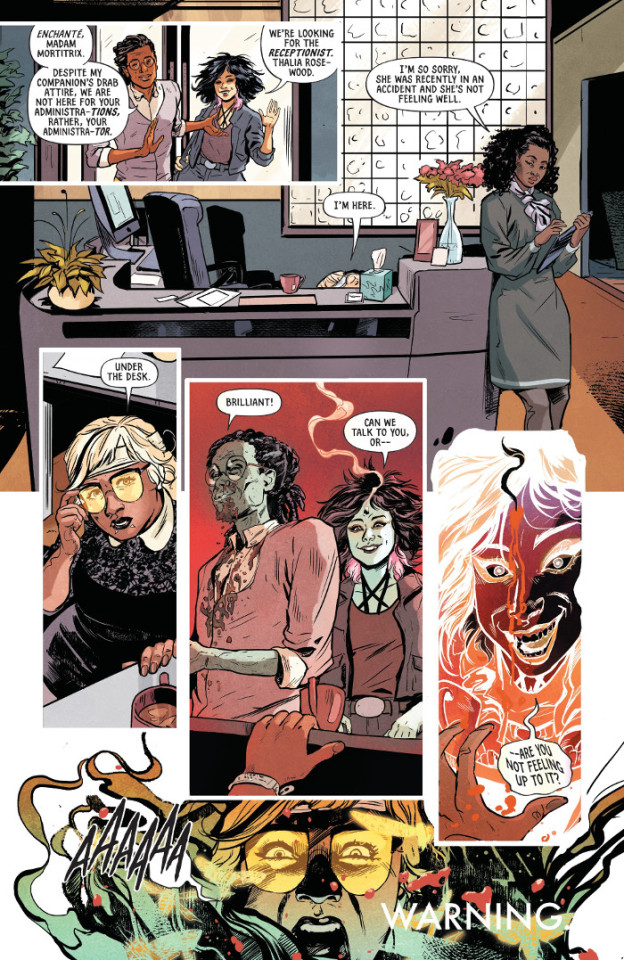

Exiles #7 concludes the Old West-ish arc with cowboy T’Challa. Drop dead gorgeous artwork from guest artist Rod Reis. His depiction of the ultimate villain here shows some nice influence from Bill Sienkiewicz.
| Published by Marvel



Extermination #2 brings the fight to the school, even as the team (and the reader, although it’s not a bad thing) is still confused as to what is really going on. I love this, the tension that Ed Brisson, Pepe Larraz, and Marte Gracia are building is palpable, and the hints of kid!Cable’s actions are chilling. Also, the art is just phenomenal.
| Published by Marvel

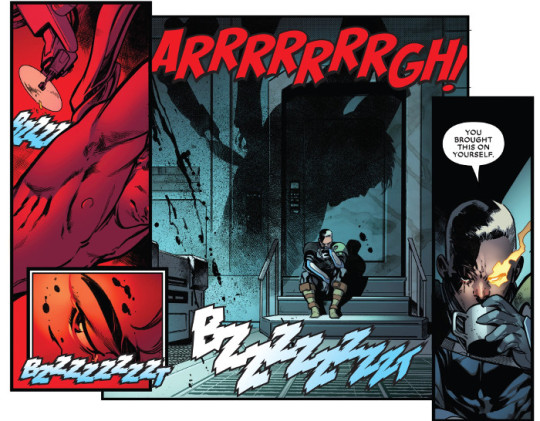

Harbinger Wars 2 #4 is kind of the end to this, but the ramifications and fallout are all supposed to appear in the Aftermath issue. That being said, Matt Kindt, Tomás Giorello, Renato Guedes, Diego Rodriguez, and Dave Sharpe go all out for the spectacle in this final confrontation between Livewire and X-O Manowar. It is still kind of insane how Capshaw could possibly consider what GATE and OMEN have done as being “good”, especially in light of Palmer going absolutely batshit insane, but it does lead to interesting set-up for future conflicts.
| Published by Valiant

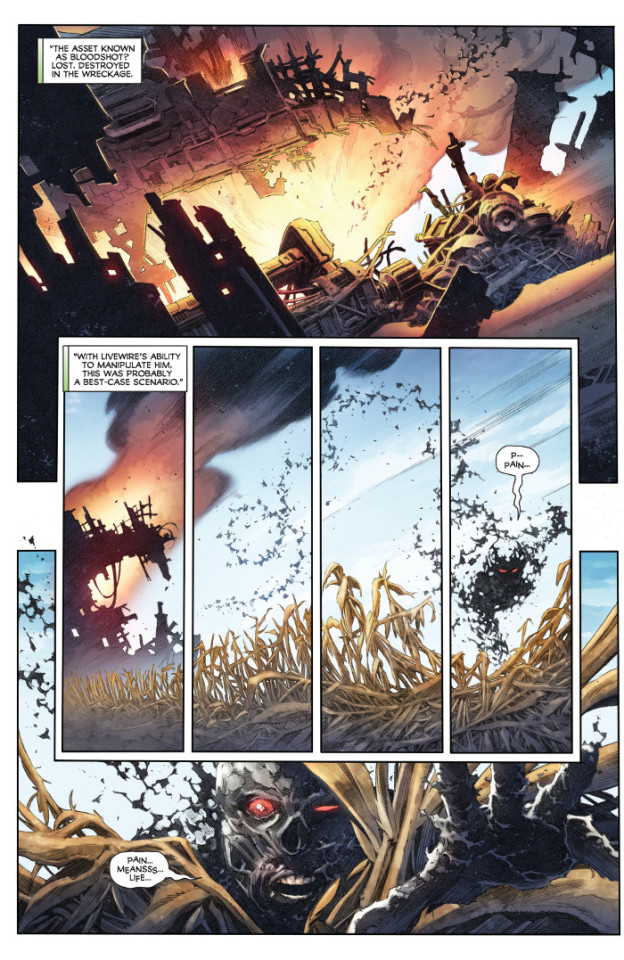

Hillbilly: Red-Eyed Witchery From Beyond #1 begins the next adventure of the black-eyed tramp. I get a bit of a Beowulf vibe from Eric Powell’s set-up and I’m interested to see where it goes. This series sees Powell passing on the artistic duties to Simone Di Meo, Brennan Wagner, and Warren Montgomery and it’s an interesting visual shift from the washes of Powell’s own work in the original series. I quite like Di Meo’s style, which reminds me a bit of James Harren and Troy Nixey.
| Published by Albatross Funnybooks



House Amok #1 is something I’m not sure I can describe. It’s kind of a family drama, but if that family were all collectively sharing a hallucinatory experience or delusion. It’s a very interesting concept that’s only partially revealed by Christopher Sebela, Shawn McManus, Lee Loughridge, and Aditya Baker, but it leads to a very compelling start here. Gorgeous artwork from McManus and Loughridge.
| Published by IDW / Black Crown

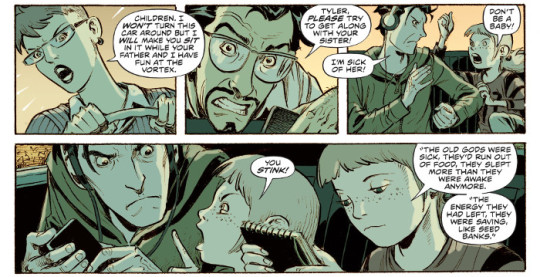

Hunt for Wolverine: Dead Ends #1, like all four of the Hunt for Wolverine mini-series, is kind of a bit of treading water. I cannot say it or any of the previous series are bad, taken on their own separated from this “event”, they’re usually quite good, but as a whole it’s kind of disappointing. It’s a search for Wolverine that kind of comes up empty, acting as a prequel to the return of Wolverine, despite already having returned in Marvel Legacy and hopped across numerous different titles, before apparently being used for evil, as per throwaway bits in the fourth issues of those previously mentioned minis that didn’t necessarily connect with the plots of those minis. It feels a bit scattered and unnecessary, unfortunately, especially when it comes to comparing notes, coming up with the organization we already knew was behind it, and a bit of hand-waving mystery and grandstanding that still tells us a whole lot of nothing. It’s sound and fury. All of which is a bit of a shame because I otherwise generally enjoy the work of Charles Soule and Ramon Rosanas.
| Published by Marvel



Isola #5... Just look at the artwork. Karl Kerschl and Msassyk just keep delivering page after page after page of beauty.
| Published by Image

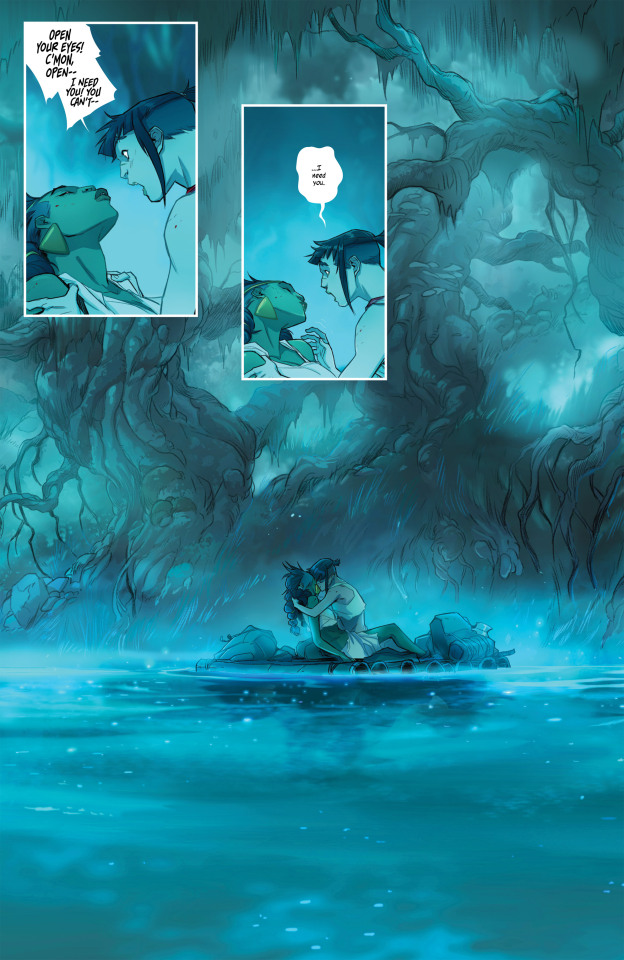

Jessica Jones #2 reaffirms that this is one of the best things that Marvel is currently publishing, with the next two chapters in this story. Kelly Thompson’s dialogue, narration, and banter throughout this issue is spot on, propulsive, and funny as hell when it needs to be, but what elevates it is that this isn’t your typical talking heads approach. The characters are doing stuff, like hunting sea monsters, instead of sitting at a desk or whatever. It’s a refreshing change that overall just makes this all the better. Not to mention Mattia De Iulis’ stunning artwork. It’s slick and polished with a line style that somewhat reminds me of Paul Gulacy and a bit of Rick Mays, and an approach to shadow and colour similar to Frazer Irving. This is a great series that really shouldn’t be missed.
| Published by Marvel



Judge Dredd: Under Siege #4 wraps up this entertaining series from Mark Russell, Max Dunbar, Jose Luis Rio, and Shawn Lee. I really like Dunbar’s take on Dredd and the Russell’s idea of people creating their own law in the absence of law is an interesting philosophical counterpoint to the idea of man naturally sliding towards a state of chaos. Even the mutants striving for society is an interesting challenge to the typical idea of things falling apart.
| Published by IDW



New Mutants: Dead Souls #6 concludes the series with Illyana putting the pieces together for what actually has been going on, it isn’t a pretty picture. This has been a great series from Matthew Rosenberg, Adam Gorham, Michael Garland, and Clayton Cowles and the revelations this issue are heavy. The implications for the X-universe is huge and I want more.
| Published by Marvel

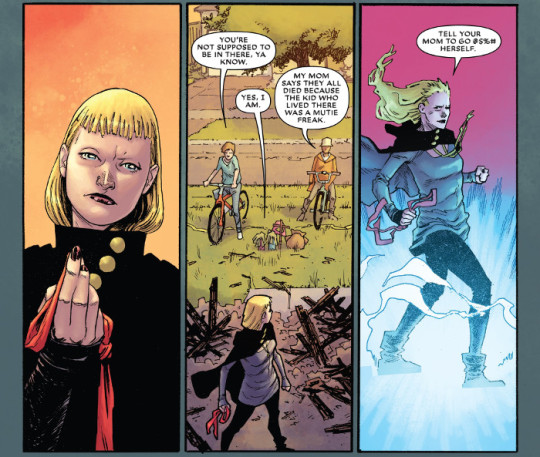

The New World #2 essentially reveals itself as a romance comic, amidst the ultraviolence and social engineering. Didn’t really see that coming, but it’s an interesting move. Trippy art from Tradd Moore, Heather Moore, and Ludwig Olimba.
| Published by Image



Paradise Court #2 continues to be an entertaining horror comic from Joe Brusha, Babisu Kourtis, Leonardo Paciarotti, and Taylor Esposito. This gives us the part of the story where our protagonist is experiencing the horror and everyone else is telling her she’s just imagining it, but it’s still well told and well illustrated.
| Published by Zenescope

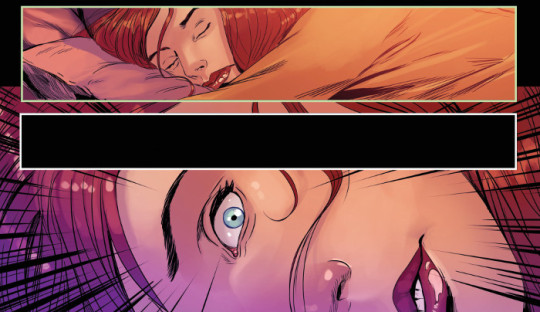

Rick and Morty vs. Dungeons & Dragons #1 is about as perfect a crossover of two properties as you can get. Morty trying to get into D&D because he thinks it will get him laid is the perfect in to the world of the game and the cartoon, perfectly blending the two for fans of both without alienating or diminishing either. Jim Zub, Patrick Rothfuss, Troy Little, Leonardo Ito, and Robbie Robbins are faithful to both and in doing so deliver a wonderful beginning to this story, that also educates along the way.
| Published by IDW & Oni Press

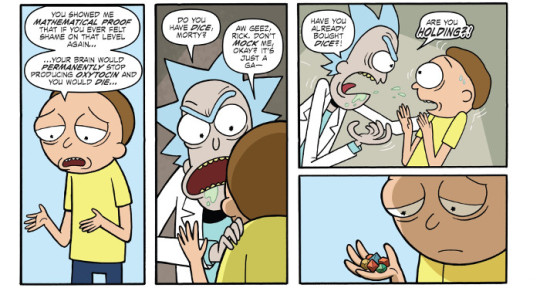

Runaways #12 is easily one of the best issues in what has already been an exemplary series. Rainbow Rowell, Kris Anka, Matthew Wilson, and Joe Carmagna focus here on forgiveness, acceptance, and second chances, with some truly beautiful character work between Gert & Victor and Nico & Karolina. If you don’t have a giant grin on your face by the end of the issue, I question your humanity.
| Published by Marvel



Submerged #2 is still weird, very weird, but there’s some really good bits in here demonstrating some of the emotional manipulation that family members sometimes employ. Beautiful, ethereal artwork from Lisa Sterle and Stelladia.
| Published by Vault

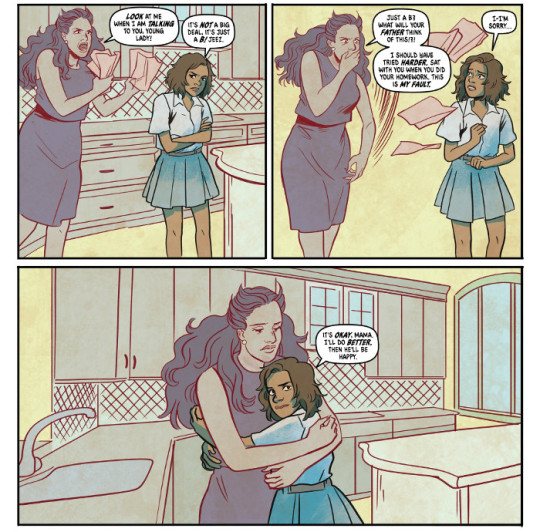

Venom: First Host #1 is somewhat strange to see in light of where Donny Cates and Ryan Stegman have taken the character, but this limited series from Mike Costa, Mark Bagley, Andrew Hennessy, Dono Sánchez-Almara, and Clayton Cowles serves as both an interesting addendum to the symbiote’s history and as a continuation (and likely capstone) to the previous creative team’s run. It’s pretty decent.
| Published by Marvel

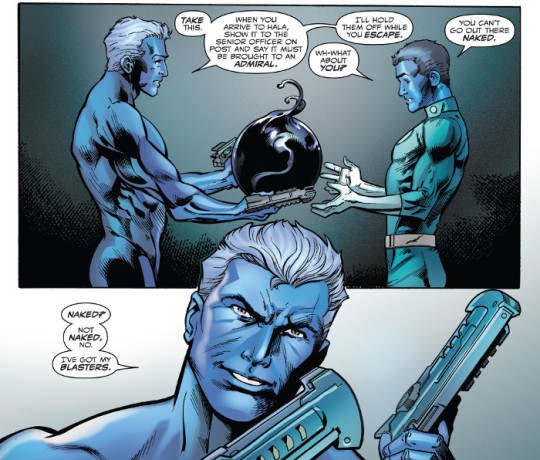

Web of Venom: Ve’Nam #1 is a one shot fleshing out the backstory of Rex Strickland and the SHIELD experiment that bonded the early symbiotes to soldiers set loose during the Vietnam War. It’s an entertaining tale with some nice guest stars and sweet art by Donny Cates, Juanan Ramírez, Felipe Sobreiro, and Clayton Cowles. I particularly like the scratchy, faded look in the art to make it look a bit “old”.
| Published by Marvel

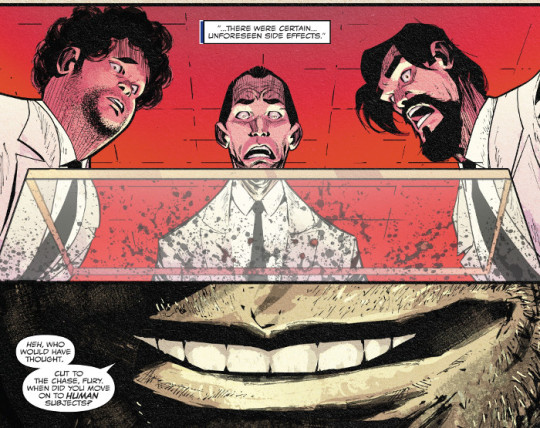

X-23 #3 is great. Mariko Tamaki has nailed the characters and the art from Juann Cabal and Nolan Woodard is incredible. The page designs alone elevate the storytelling immensely.
| Published by Marvel

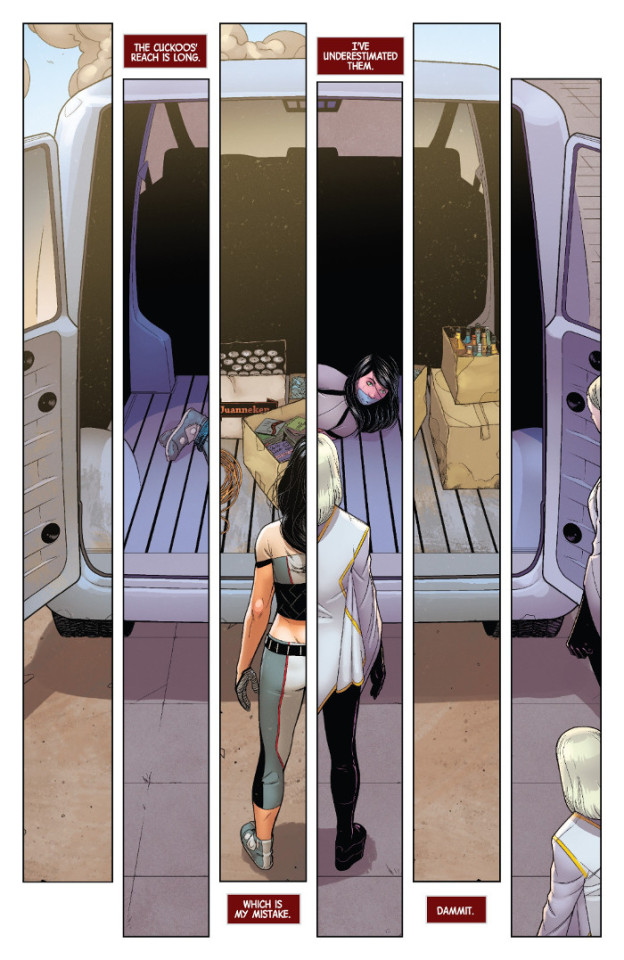

The X-Files: Case Files - Hoot Goes There? #2 concludes the second of this new approach of a series of mini-series and it’s...weird? Funny, but weird. Definitely taking a page out of some of the more outlandish episodes of the series, where you question whether or not what you saw happened actually happened. Still, it’s entertaining, which is all that really matters. Fun from Joe and Keith Lansdale, Silvia Califano, Valentina Pinto, and Shawn Lee.
| Published by IDW



X-Men Blue #34 looks like it largely serves as a capstone to Cullen Bunn’s work with Magneto over the past four years or so, as he winds down his run here and continues to tidy the characters up a bit before he’s done and hands the reins off to the next band of storytellers. It feels like there’s a lot more here that he would have like to have told, but what we get here is still excellent. The hints at the next stage for Magneto and mutantkind are intriguing. Great art from Marcus To and Matt Milla.
| Published by Marvel

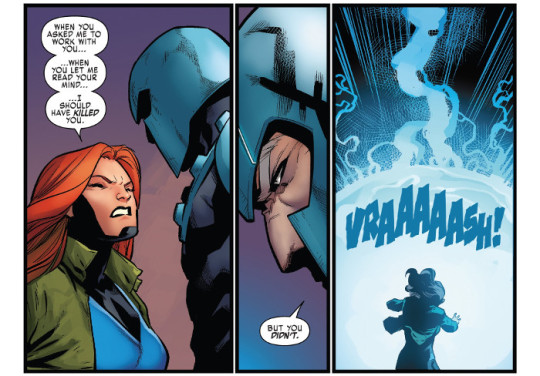

X-O Manowar #18 gives an interesting transition from this flashback of Aric’s pre-Shanhara life to his return to Earth, focusing on how ideas, people, and culture keeps changing. Matt Kindt delivers a pretty chilling reaction to it. All with some nice artwork from Trevor Hairsine, Brian Thies, and Diego Rodriguez.
| Published by Valiant

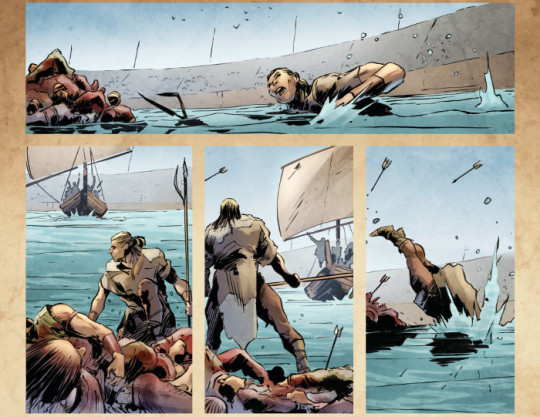

Other Highlights: Deadpool: Assassin #6, GI Joe: A Real American Hero #255, KINO #9, Marvel Two-in-One #9, Mighty Morphin Power Rangers: Shattered Grid #1, Modern Fantasy #3, Moon Knight #198, Ms. Marvel #33, Red Sonja #20, Rick & Morty #41, StarCraft: Scavengers #2, Star Wars: Lando - Double or Nothing #4, Star Wars: Poe Dameron Annual #2, Star Wars Adventures #13, TMNT: Bebop & Rocksteady Hit the Road #5, Wayward #28, X-Men: Grand Design - Second Genesis #2
Recommended Collections: 2021 - Volume 1, 30 Days of Night, Big Trouble in Little China: Old Man Jack - Volume 1, Black Cloud - Volume 2: No Return, DuckTales Classics - Volume 1, Eugenic, Factory, Femme Magnifique, I Hate Fairyland - Volume 4, James Bond: Hammerhead, Judas, Killer Instinct, Stray Bullets: Sunshine & Roses - Volume 2

d. emerson eddy is not the very model of a modern major general. Nor a scientist salarian for that matter.
9 notes
·
View notes
Text
15 Best Legend of Zelda Boss Fights Ever
https://ift.tt/3ine4lg
Boss fights have been one of the pillars of The Legend of Zelda series since its inception. Link enters a dungeon, finds a new weapon, and often uses it to take out the big baddie that’s established residence there. It’s a solid formula that’s worked for over three decades now.
Not all Zelda bosses are created equally, though. Many are easily forgotten. Others, like Ocarina of Time’s Water Temple guardian Morpha…well, we just wish we could forget them. Of course, we’re here to celebrate the bosses that often defined the games they were in and helped establish The Legend of Zelda as one of the greatest series in gaming history.
You might also notice that some of the better Zelda games, namely Breath of the Wild and Link’s Awakening, aren’t represented on this list, while some of the more maligned games in the series do show up. The bosses on this list don’t necessarily hail from the best Legend of Zelda games, but they are among the most unique and creative in the history of this in the storied franchise.
15. Crayk – The Legend of Zelda: Phantom Hourglass
With its low overall difficulty level and emphasis on using the DS’s touch screen controls, Phantom Hourglass isn’t well regarded by many Zelda fans. Still, it’s hard not to be impressed with the ways Nintendo intelligently used the handheld’s two screens as the basis for one of the series’ most unforgettable boss fights.
Crayk turns invisible on the bottom screen, but on the top screen, you can see the room from his point of view. You have to use the top screen to figure out exactly where Crayk is so you can shoot an arrow at his eye and turn him visible before going in for big damage.
14. Helmasaur King – The Legend of Zelda: A Link to the Past
The Zelda series started in 2D, and while those early games are all-time classics, most of the bosses from that era honestly haven’t aged that well. However, Helmasaur King, the first boss in A Link to the Past’s Dark World, is still a standout all these years later.
First, Link has to use bombs or arrows to remove the giant lizard’s mask. It’s only then that you can expose this boss’ weak point and finally go in for the kill. It may sound simple, but that combination of action and puzzle-solving became the template for most future boss fights in the series.
13. Vaati – The Legend of Zelda: The Minish Cap
The Minish Cap is an oddball Zelda game for a few reasons. Capcom handled development instead of Nintendo, it’s the final fully 2D “classic” Zelda game to date, and it’s one of the few games in the series that doesn’t even mention Ganondorf.
The evil sorcerer Vaati may not get as much love as Ganondorf, but he is the star of this epic multi-stage final boss fight. This battle requires Link to use all of the abilities he’s acquired during his adventure just to survive. That means dividing himself with the Four Sword to take out Vaati’s four eyes simultaneously before shrinking himself to enter the mage’s arms and deal damage from the inside out.
12. Gohma – The Legend of Zelda: The Wind Waker
Gohma is far from the toughest Zelda boss (he’s actually the very first dungeon boss in Wind Waker), but he makes up for a lack of difficulty with his imposing design and the fact he’s just so much fun to beat up. Gohma may be an absolutely massive, armored, fire-breathing bug unit, but it turns out that armor doesn’t help him much when Link shows up.
The key to defeating Gohma is to hookshot the tail of Valoo (the dragon you’re there to rescue). That will make Valoo drop rubble on Gohma’s head, giving Link the opening he needs to hookshot Gohma’s eye and go in with his sword. This fight is just a fantastic combination of mechanics, environment, and execution.
11. Goht – The Legend of Zelda: Majora’s Mask
With its 72-hour time loop and complete absence of series mainstay Ganondorf, Majora’s Mask was the first title in the series to break away from a lot of The Legend of Zelda’s conventions and redefine what a Zelda game could be. Some gamers dislike it for that. Personally, I’m a big fan.
While most of the temples and bosses in Majora’s Mask don’t stray from Ocarina of Time too much, Goht is the appropriately giant exception. This massive bull creature charges around a circular arena throughout the battle and the only way to stop it is to change into Link’s Goron form and ram him at full speed. It’s a boss fight mixed with a destruction derby, and it’s a truly unique encounter for this franchise.
10. King Bulbin – The Legend of Zelda: Twilight Princess
Most of the better boss fights in Zelda history focus on creative uses of the various items Link finds. King Bulbin isn’t one of those fights. Actually, the first phase is just a mad dash through Hyrule Field as Link, on horseback, tries to hack away at Bulbin while being swarmed by even more riders.
What really elevates this battle, though, is the iconic duel on the Bridge of Eldin. You only have to hit the king with your sword twice to defeat him, but without any guard rails, it’s easy to fall to your death. There’s a reason why this moment has been immortalized as a Super Smash Bros. stage. It’s one of the most memorable scenes in franchise history.
9. Dark Link – The Legend of Zelda: Ocarina of Time
Dark Link is technically a sub-boss, but this encounter is too cool to leave off the list. You meet Dark Link near the end of Ocarina of Time’s much-maligned Water Temple in what at first seems to be an unusually calm room. It’s only when Link’s reflection in the water goes missing that it becomes apparent that something is amiss.
No matter how you attack Dark Link with the Master Sword, he will counter your moves perfectly. It’s that premise, and the way it forces you to find new ways to deal with such a powerful foe, combined with the set-up that makes this one of the most creative bosses in any Zelda game.
Read more
Games
15 Strangest Legend of Zelda Unsolved Mysteries and Urban Legends
By Matthew Byrd
Games
The Legend of Zelda: What is the Origin of Link’s Name?
By Matthew Byrd
8. Argorok – The Legend of Zelda: Twilight Princess
Throughout its many installments, the Zelda series has actually been really good about coming up with unique enemy designs. So if a somewhat generic dragon shows up, he better put up one hell of a fight. Thankfully, Argorok delivers.
Argorok starts the fight in the air but can creatively be brought to the ground by latching on to him with your double clawshot and then equipping your iron boots to bring him crashing down. That takes care of the dragon’s armor, but it’s not the end of the fight, as Link spends the rest of the battle using his clawshot to zip around while targeting the weak spot on Argorok’s back.
7. Twinrova – The Legend of Zelda: Ocarina of Time
Ocarina of Time is full of memorable boss battles, but Twinrova stands out as the best temple guardian boss in the game.
The first phase of the battle requires Link to absorb this pair’s elemental attacks (fire and ice) with his newly obtained mirror shield before reflecting them back at the sister who controls the opposite element. That’s not the end of the battle, though, as the sisters combine into one entity for the final showdown. This time, Link has to absorb each element three consecutive times before firing back at Twinrova and finishing the job with some truly satisfying sword strikes.
6. Stalblind – The Legend of Zelda: A Link Between Worlds
A Link Between Worlds really doesn’t get enough recognition for being an excellent spiritual sequel to the beloved A Link to the Past as well as one of the better showcases of stereoscopic 3D on the 3DS. That technology is used to power Link’s best new skill in this game: the ability to turn himself into a flat piece of art and do his best sidescroller impression.
That ability is essential for a lot of the game’s puzzles, but one of its best uses is found in the fight against Stalblind. This massive boss uses a shield to block Link’s attacks, but Link can turn himself flat onto Stalblind’s shield, which confuses the enemy and forces him to put the shield on his back. That’s the only opening Link needs in this simple, yet brilliant, boss fight.
5. Puppet Ganon – The Legend of Zelda: Wind Waker
While many Wind Waker fans think the final battle with Ganondorf is the best in the game (and one of the best in the series), it’s ultimately a fairly simple fight, even if the setting is quite dramatic. Puppet Ganon is just a much more strategic encounter, and I’d argue that the setting is even better.
First, this is a really cool incarnation of Ganon unlike anything else in the franchise. It probably wouldn’t even work in another game, but here, Wind Waker’s cartoony style gives the puppet boss an especially creepy vibe. It’s really rather haunting watching this entity’s limbs dangle limply as it moves around the room before morphing into its even freakier spider and worm forms. It’s also ingenious how each of the forms requires you to use skills gained throughout the game to put this puppet away forever.
4. Stallord – The Legend of Zelda: Twilight Princess
The fight against Stallord doesn’t even feel like a traditional Zelda boss fight, but that actually works to its advantage.
Stallord is certainly one of the cooler-looking bosses in the series (it’s a giant demonic fossil protruding from the sand), but the creature is no match for Link’s trusty Spinner: a top that kind of acts like a skateboard. Even Nintendo couldn’t resist cashing in on Tony Hawk. The Spinner is mostly used to ride rails, but in the first phase of the Stallord battle, Link uses it to dodge enemies and crash into the resurrected fossil. The second phase is even better, with Link riding the spinner up a pillar to take down Stallord’s floating, fireball spewing skull.
3. Koloktos – The Legend of Zelda: Skyward Sword
Though it was well-reviewed at launch, a lot of gamers have turned sour on Skyward Sword over the last decade for a simple reason: its motion controls were unreliable. Still, there’s a solid Zelda game under the frustration, and when the controls do work, they really enhance the game. So far as that goes, Koloktos is the prime example of Skyward Sword at its very best.
To defeat this six-armed automaton, Link first has to use his newly acquired whip to remove the arms Koloktos uses to guard his weak point. Deal enough damage, and Koloktos then grabs six swords for each of its hands. You’ll again have to use the whip to remove his arms, but this time, you have to pick up one of the swords it drops to slash at the weak spot for massive damage. It’s an oddly visceral and satisfying boss fight that stands out even when compared to the best encounters in the series.
2. Majora’s Mask – The Legend of Zelda: Majora’s Mask
Between the magical masks, 72-hour time loop, and the ever-looming threat of the moon crashing into everything, Majora’s Mask is one trippy game. It’s fitting, then, that the final battle against the titular villain is truly psychedelic. After stopping the apocalypse and entering the moon, Link finally comes face-to-face with Majora’s Mask. The first phase just sees the mask floating around a hallucinatory room, but for the next two phases, the creature sprouts legs and, finally, tentacles.
There are actually two ways to defeat Majora’s Mask: the strategic way or the badass way. The first method requires switching masks and strategies and quickly moving around the room while carefully avoiding attacks. The second method, which is arguably more fun, is to obtain all 23 masks in the game and collect the all-powerful Fierce Deity Mask for your efforts. That mask allows a nearly invincible Link to just beat the hell out of Majora’s Mask in a couple of minutes. No other Zelda game ends quite like that, but then again, there’s no other Zelda game quite like Majora’s Mask.
1. Ganondorf/Ganon – The Legend of Zelda: Ocarina of Time
There might be some bias here for those of us who grew up playing Ocarina of Time, but more than two decades later, this boss fight still holds up remarkably well.
First, there’s the atmosphere and sense of foreboding. After several dozen hours adventuring through Hyrule, gathering the seven sages, and breaching Ganondorf’s castle, you finally confront the face of all evil in the land…and he’s eerily playing his theme on the organ. Admittedly, the first phase of this fight is kind of silly (it’s basically a game of tennis as Link and Ganondorf exchange a ball of energy back and forth), but where this boss fight truly stands out is in its second phase. It’s there that you confront Ganon: a towering pig beast wielding two massive swords in an arena surrounded by a ring of fire. The strategy here is pretty simple (just get behind him and strike his tail repeatedly until Link can land the killing blow) but it’s such a cinematic moment and satisfying conclusion to a classic game that it’s hard not to consider it the best boss fight in franchise history.
cnx.cmd.push(function() { cnx({ playerId: "106e33c0-3911-473c-b599-b1426db57530", }).render("0270c398a82f44f49c23c16122516796"); });
The post 15 Best Legend of Zelda Boss Fights Ever appeared first on Den of Geek.
from Den of Geek https://ift.tt/2UkeSj0
0 notes
Link
via Politics – FiveThirtyEight
Public furniture, large art installations and trees can all make cities more livable. They can also make cities safer.
Researchers, urban planners and community activists say that city design is one of the best ways to ward off the growing threat of terror attacks that use motor vehicles as a weapon, the most recent of which occurred in New York City last week. The approach — which separates cars from pedestrians and cyclists by using physical barriers that are capable of stopping a moving vehicle and that can also function as environment-enhancing installations such as benches or planters — allows cities to help protect people and buildings while maintaining and even enhancing a city’s everyday function as a place to live and work.
Some groups have called for increased surveillance and arming police with new technology in order to prevent future attacks. But those tactics come with civil rights concerns or rely on technology that doesn’t yet exist. Meanwhile, using urban design to make cities safer has the support of a number of groups, including pedestrian advocates, urban planners and security experts. That’s partly because the changes can make cities safer, even in the absence of a terrorist attack.
The increasing frequency with which people have been driving into crowds as a tool of terror may be related to a 2010 article that promoted the tactic in a magazine purportedly linked to Al Qaeda. More recently, ISIS-linked publications have also latched on to the tactic. In the last few years, vehicles have been used for attacks in several European cities, including London; Nice, France; and Barcelona, Spain. On Tuesday, an attacker drove a truck down a bike path in lower Manhattan, striking pedestrians and cyclists and killing eight people.
Vehicles are an effective weapon, terrorism experts say, because they require no special skill or training to operate, and they are both easy to get and ubiquitous — seeing a truck drive down a street doesn’t set off any alarm bells for law enforcement or bystanders. That has led security experts and urban designers to look for ways to physically separate the spaces where cars travel from areas designated for cyclists and pedestrians.
These barriers can be effectively incorporated into spaces so that they aren’t just security tools, according to Jon Coaffee, a professor at the University of Warwick in England who has written about urban design and security. In fact, they already are. These devices appear in cities all over the world, but even city dwellers who see them every day may not realize their purpose. In the academic world, design solutions that serve a secondary purpose are labeled as having increased “acceptability” compared to the concrete walls and similar temporary barriers that are often erected to protect buildings or spaces. People like them because they improve a city space without making it feel like a police state.
Tourists walk by recently installed bollards in Lisbon, Portugal.
Horacio Villalobos / Getty Images
Cities have long put security barriers around government buildings. After the Oklahoma City and World Trade Center bombings, when officials were particularly concerned about truck bombs, barriers were installed around a number of important structures. Concrete posts at an airport in Glasgow were credited with preventing deaths during one of these attacks in 2007.
With terrorists attacking “soft” targets — places without a lot of security, like the Christmas market in Berlin in 2016 or the bike path in New York City last week — questions have arisen about how cities can protect a variety of spaces without impeding their daily function. Concrete slabs and other drab or militaristic-looking barricades are not necessarily embraced by the public: Temporary concrete cubes placed in Melbourne, Australia, after an attack there became the focus of a renegade art installation run by residents and artists who found the barriers ugly.
While it’s impossible to fully protect every space where people congregate, the goal, wrote Coaffee, is to make spaces safer without making them feel like they were built for security instead of urban living. “The predominant view that is emerging is that security features should, where appropriate, be as unobtrusive as possible,” he said in an email. That means focusing on making installations aesthetically and functionally pleasing.
Take, for example, the fortified concrete letters spelling out ARSENAL outside of the stadium where the soccer team plays in London, a favorite place for fan photos, according to Coaffee. Or the heavy concrete planters placed around small parks and seating areas in New York City that mark the boundaries of pedestrian areas, but also stop vehicles from being able to enter.
Arsenal fans arriving for a soccer match at Emirates Stadium in London are greeted by lettering spelling out their team’s name and blocking cars from driving onto the sidewalk.
Steven Paston / Getty Images
Cycling and pedestrian advocates have called for an increase in these kinds of installations for years, well before the recent uptick in vehicle-based terrorist attacks, since they can prevent accidental injuries as well, said Caroline Samponaro, deputy director of Transportation Alternative, an organization that has promoted biking and walking in New York City since the 1970s. She noted that people are hit by cars every day in New York City — by the end of September, 97 pedestrians and cyclists had died and more than 10,000 had been injured in crashes in 2017 alone, according to city data.
Samponaro’s organization has advocated for the use of bollards, which are essentially posts used to control traffic. They can be made of concrete, plastic or other materials, though those made of lightweight material can only guide traffic, not stop cars from entering protected areas. Bollards can be permanent, removable or retractable. They come in a variety of designs and styles to match the needs of a space. They can be placed at street corners to force cars to turn on a more narrow radius, which slows vehicles down, or across entryways to spaces designated for bicycles and pedestrians.
Security gates and bare concrete barriers, at left, funnel foot traffic outside the All England Club at Wimbledon in London. Artists and residents decorated the large concrete blocks, at right, that were installed in Melbourne, Australia, to block vehicle access to city pedestrian zones.
GETTY IMAGES
Bollards were broadly promoted after 2006, when cyclist Eric Ng was killed by a drunk driver who drove through a different section of the bike path where last Tuesday’s terror attack occurred. A task force was assembled, and bollards were recommended. But at the time of the attack, there were no barriers at many of the path’s entrances.
Samponaro stressed that although these types of attacks draw more attention than everyday accidents, city design solutions shouldn’t be handed over to security experts. “The goal shouldn’t be to create a police state based on fear. It’s possible to have thriving, dynamic, accessible spaces for people,” she said. “That doesn’t mean a threatening environment.”
5 notes
·
View notes
Text
What It Means Like To Love A Musician.
“Without music, life would be a mistake.” ~ Friedrich Nietzsche When you fall in love with a musician, it will wash over your insides like a force you’ve never known. You will marvel at its impact and find yourself changed in its wake. What was that? you’ll ask, and there he’ll be: your very own, bonafide music-maker. You’ll fall for his presence, his charisma and confidence. You’ll feel powerful and sensual and creative when he’s near, like glitter has been embedded into everything in your waking consciousness—quite suddenly, you will see the world how it was meant to be seen. For if ever there was a connection to the ethereal, therein music lies the conduit. A musician doesn’t leave music on the stage, that’s his special power: it pumps through miles of veins. Stretched end to end, his veins and arteries can wrap the globe, so it’s no wonder that his very pulse stirs you so. As he moves through rooms, it fills the space around him. As he sits still, it buzzes over skin. Music is in his heart, his speech, his gait and his smile. That’s what you’ll fall for. And if you’re lucky enough to find a music-maker who is kind and intelligent and witty beyond his charm, you’ll hold onto him. You’ll wonder where he came from and why the universe chose you of all people to be his. You are the musician’s wife—you are as backstage as it gets. You’ll bear witness to madness and magic. The life of a musician is a many-fabled thing. He spends more time driving, handling gear and waiting than he does playing, partying or tending to fans. Fettered by a battered van, stretches of highway and rest stop after florescent-lit rest stop, the musician knows boredom as intimately as adventure. But to see him off on these experiences—tedious or incredible as they may be—will weigh heavily on your heart. You will say goodbye to him again and again; at first, it will seem easy, and soon after, impossible. Your heart will tighten days before his departure, protesting as forcefully as she can. You’ll face resentment and a fear you didn’t know you could harbor. You will feel stupid for being so sad and despise yourself for not being stronger—but gone is gone, no matter how many miles separate you, and you prefer him here. You will learn though, that you don’t have to fear the road. Anticipation will outweigh the absence. You’ll feel the distances extend and recoil as he weaves across the country—that’s how connected to his heart you will be. So to love a musician, you must learn to be alone. You’ll be the man of the house in his leave. You’ll take out the trash. You’ll fix things, you’ll cook, you’ll clean. This will be necessary. When he’s on the road, you will attend soccer games, run school drop-offs and pick-ups, read bedtime stories and do nighttime tuck-ins alone. You won’t stop from the moment you wake up to the moment you sleep. You’ll wonder how much you are capable of handling, then realize it doesn’t matter much because these things have to be done. This is what it takes to love a musician—these are the ways you support a dream. You’ll hoard moments to share. You’ll be prepared when you receive that quick-phone call; but when the moment comes, you’ll feel rushed and silly and ill-equipped to make him understand that life at home is wonderful, but he is conspicuously absent. You’ll choose words delicately—he needs to know he’s missed without arousing guilt. You’ll stumble a bit when you follow his tour narratives with domestic odds and ends that feel small and unimportant in comparison. But you’ll understand over time: there is no such thing as unimportant. Tour will exhaust him and he’ll forget what normal feels like. You are his normal, and he needs to be reminded of you. After a few dozen farewells, you’ll begin to appreciate it more: the quiet, the freedom to watch as many old movies as you and your cat can stay awake for. You’ll use sleepless hours to write and sip tea and think about the future you’re making with your music-maker. When your eyelids grow heavy in the earliest hours of the morning, you’ll button up the house—checking and double checking that you and your children are safe for this night. You’ll retire to a big, empty bed with cool sheets. You’ll sleep a little closer to his side. You’ll imagine crawling into his shirt pocket and you’ll button yourself up, close to his heart. Your own heart will unfold like truth while you dream; she’ll speak to the stars on your behalf, asking them to erase the miles between you. And when he returns home from the road, you’ll follow him around the house like you haven’t seen him in years. Like you’re sure that at any moment he might disappear before your eyes. You’ll appreciate all over again what the house feels like when it’s infused with his music. You’ll notice details: the way he stands, the way he positions his body while he cooks—always weighted a little more to the left. You’ll notice the way he smiles when he talks about band pranks, great rooms and memorable fans. It means late nights—impossibly late nights. But when he’s home, late nights mean hours of laughter—to the point of tears—and intense conversation. You’ll solve problems big and small. You’ll talk about your kids, about human nature, about culture and science. You’ll make connections between his knowledge of music and your knowledge of literature. You’ll talk about his career—you’ll know his thoughts and options so intimately, you’ll treasure them as your own. You’ll know not to base successful nights on money-earned, but on attendance, reception, on how the room felt. Because it is the craft that matters. Hone the craft and the rest will follow. You must trust the process—more fervently than even him. Love a musician and love the unpredictable, the chaotic and the untraditional. Loving a musician means loving his work, even when it’s inconvenient, even when it isn’t lucrative, even when it seems crazy, illogical, impractical. Understand that without the art he is not whole. Abandoning the craft would be abandoning a very piece of himself—the most honest piece he has. Offering your heart to this man means knowing that the 30 minutes of practice, the 15 minutes of Youtube research, the not-talking during the four-minute song he chose for the car ride, these minutes matter. They’re the meditation, the grounding, the breath required to sustain a healthy sense of connection. Time changes; you must accept open-ended timelines and an inability to commit to long-off engagements. Appointment times, lunch times, meet-for-coffee times are soft suggestions when you’re running on musician time. Love doesn’t necessarily translate to traditions like marriage and honeymoons, because ‘tradition’ will take second seat to exploration and expansion. If this isn’t a deal-breaker, you’ll have a wild, beautiful, intense romance with your music man. You’ll celebrate each other without ceremony (again and again and again). You’ll experience passion and spontaneity alongside depression and heavy contemplation. The art will abuse you as it abuses him, but then he’ll be rewarded with a breakthrough of any degree and you’ll both forget that anything was difficult. Ever. To love a musician, you must share him. You must share him with the brothers he call bandmates. These brothers are undeniable family—family that loves, family that bickers—and you’ll take comfort that they’re on the road together. You must share your musician with total strangers too. This can be difficult, but hold it in your heart that he returns to this home, always. And the time you invested in having the space he returns to tidy won’t go unnoticed. When he drops his travel bags to the floor for the cat to investigate, when he removes his shoes with animated grunts and sits on the couch you’ve watched a million movies together on, he’ll sigh deep from his belly and you’ll know he has been waiting for this moment since the minute he left. He’ll be home and you’ll smile and laugh and kiss that kind of over-the-moon, I-can’t-get-enough-of-your-taste kind of kiss. You’ll laugh and say, that was crazy, right? But you made it. This life is crazy, but you’d hate to know crazy with anyone but him, even on the worst days. Because he makes your crazy seem less crazy—somehow tolerable, or normal, or incredible. And you’ll look in his eyes and say, I love your crazy and miss it when you’re gone. He’s here and you both made it. Just like you made the last run work, the last few years, the growing pains, the sadness, the tired days and nights. Just like you made it through the band changes, the band break-ups, the sacrifices required for success. drummer, music, manAnd when he plays close to your home, it will be essential to get out to see him. This might seem silly, as it’s part of the reason you fell in love with him after all. As years pass, you’ll accept that you can’t make it to every show, and you’ll grow comfortable in your routine. You must make the effort; you must always make the effort to go out and see the magic—the gold he spins from simple wool. While you watch, you’ll fall in love again. You’ll feel so much pride that your rib cage will splinter trying to contain it. You’ll be so in love with him that you’ll hardly be able to wait to get him home that night, where you’ll stop sharing and selfishly devour him instead. After the load-out is complete, and you make the sleepy drive home, you’ll realize you aren’t so worried about sex after all. All that matters is that this man, your man, is lying next to you. The man that crowd watched is home safe and he’s drifting as you drift to that heart space between waking hours. The next morning, you’ll go about your day. You’ll sip coffee and write a little. You’ll listen for the sound of his footsteps on your bedroom floor, but they won’t come. Loving a musician means falling in love with morning hours because those will be yours—for a musician will chase sleep as fiercely as he chases success. He won’t know it, but you’ll watch him sleep. You’ll smile as he turns over and you’ll listen to the cadence in his breath. In his lifetime, there will be good shows and there will be bad shows. Just like you’ll have happy-lover days and bad-lover days. So long as you remember that you love each other, so long as you remind him that he loves to play, all will be right in due time. You’ll find excitement like you’ve never known and frustration like you’ve never felt. You will experience life in neon. You’ll hate everything about this life, only to contradict yourself a moment later with crippling gratitude because you’re so in love with this man and the life he’s brought with him. When you love him, impossibilities and all, you are an unsung hero. You will not be cheered on by the throngs of fans, but you and he will know how you salvaged his career, just by being there. And when foundations crumble, you will save him again. And when spirits wane, you will save him again. You are the clean-up crew, the architect, the engineer, the muse. You are the partner of a musician, a sometimes-preposterous feat. You will—through loving him—know an unshakeable love. And on the good days, your happiness will permeate the darkest crevices of this insane life. Your ability to celebrate one another will explode any doubt you’ve ever had and you’ll dance together as the smithereens fall around you like confetti. This is love, you will exclaim to the world—and anyone who looks in on you will know it is so. Relephant reads: Sara Crolick
0 notes